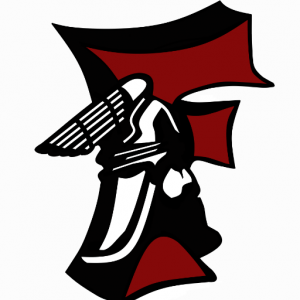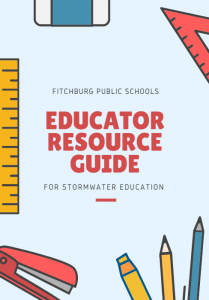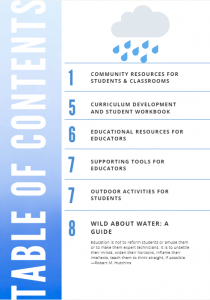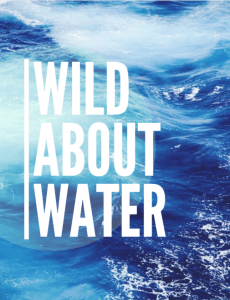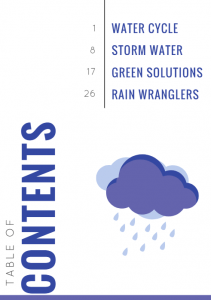Stormwater Runoff Education and Environmental Stewardship in Fitchburg
Welcome to our project page! During our Interactive Qualifying Project we collaborated with the Fitchburg Department of Public Works and Fitchburg Public Schools to create an environmental education program to instill environmental stewardship among fifth grade students.
Project Description:
Stormwater runoff is any type of precipitation that flows over an impervious surface and is not absorbed into the ground. This runoff often becomes polluted as it travels along pavement, roads, rooftops, and streets on it’s way to the storm drain. This stormwater runoff flows into a system of drains and underground pipes known as a Municipal Separate Storm Sewer System (MS4). These systems may discharge the stormwater directly into local water bodies without treatment. As a result, all the contaminants in stormwater are also discharged into the local water bodies.
In 2016 the United States Environmental Protection Agency published the Municipal Separate Storm Sewer System Permit to regulate the discharge of stormwater pollution. In order to reduce stormwater pollution, the permit establishes six control measures that municipalities must implement before Summer 2018. For this project we focused on the”Public Education and Outreach” control measure, which mandates the implementation of educational programming to city residents.
In order to assist the Fitchburg Department of Public Works with the first control measure, we created an educational program for Fitchburg Public Schools that satisfies the requirements of the MS4 Permit as well as the 2016 Massachusetts Science, Technology, and Engineering Frameworks. We created this environmental education program to empower and educate 5th grade students to become community scientists. Our goal was to help create a generation of stakeholders that are committed to the future of their environment.
Project Sponsor: Fitchburg Department of Public Works
The mission of the Fitchburg Department of Public Works (DPW) is to provide efficient, cost effective, high quality service relative to the operation, maintenance, planning, review and construction of public works infrastructure for the City of Fitchburg. During the course of this project, we worked with Jeffrey A. Murawski P.E, the Deputy Commissioner of Wastewater, and Nicholas J. Erickson P.E., a DPW Civil Engineer.
Project Sponsor: Fitchburg Public Schools
The vision of each of the Fitchburg Public Schools (FPS) is to provide learning experiences that engage all students in achieving high academic standards while developing intellectual rigor, creative interest, and social characteristics that prepare them for the challenges of living successfully and productively as citizens of this new century. We collaborated with a variety of teaching and curriculum specialists from the Fitchburg Public Schools during the development of the educational handbook and program. We worked closely with Jessica Stodulski, the STEM Specialist for FPS, during the course of this entire project.
Student Researchers
Our project team consists of:
- Sean Burke, Civil Engineering 2019
- Michael Cooke, Mechanical Engineering 2019
- Thomas Kouttron, Mechanical Engineering 2019
- Cielo Sharkus, Biochemistry 2019
Objectives and Methodology
Our project aimed to assist the Fitchburg Department of Public Works and Fitchburg Public Schools with the creation of an environmental education program, which focused on educator support and interactive education, in order to create a generation of environmentally aware and empowered students.
We focused on breaking the project down into 3 main phases:
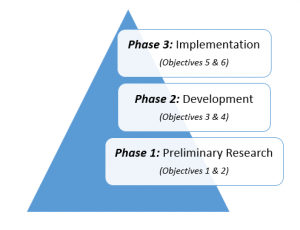
- Phase 1: Preliminary Research
- Objective 1: Understanding the 2016 State Science, Technology, and Engineering (STE) Curriculum
- Comprised independent research of the STE Frameworks, interviews with STEM education specialists, and classroom observations.
- Objective 2: Research of the Public Education and Outreach Control Measure
- Focused on independent research and interviews with various local & state officials.
- Objective 1: Understanding the 2016 State Science, Technology, and Engineering (STE) Curriculum
- Phase 2: Development of Deliverables
- Objective 3: Analyzing effective education
- Used interviews with local outreach officials, a free-listing activity with students, and interviews with ELL & Special Education specialists, to discover what comprised effective education.
- Objective 4: Developing the Environmental Education Program
- Created the main deliverables: the educator resource guide, student workbook, and educational video using findings from Phases 1 and 2.
- Objective 3: Analyzing effective education
- Phase 3: Implementation
- Objective 5: Piloting the Educational Program
- Piloted a stormwater exhibit and interactive demonstration at the Boys and Girls Club of Leominster & Fitchburg.
- Conducted a focus group of educational professionals in the Fitchburg and Leominster area.
- Objective 6: Develop Recommendations and Revisions to Educational Program
- Submitted educational deliverables for review after delivering presentations to the Fitchburg Public Schools Committee and Department of Public Works Managers.
- Objective 5: Piloting the Educational Program
Findings and Main Deliverables
Throughout this project however we have learned one central finding: That low-income cities such as Fitchburg unfortunately may not have the resources to easily implement such a program due to a number of factors.
- The first being there is a shortage of ELL teachers in the education industry, which presents a particular challenge for Fitchburg Public Schools which is home to more than 700 English Language Learners.
- Secondly, we found that there is a high turnover rate of teachers. This may be caused by a number of outside factors, and may severely limit the strength of a long-term edcuational program such as the one we are creating.
- Lastly, we found that teachers face a large shortage on time due to having to prepare for standardized tests, and the constant reviewing of already taught information.
Due to these factors it may be difficult to implement any kind of educational program to an already struggling classroom. We therefore focused on supporting both students and teachers through the creation of parallel resource guides. These guides were created to instill environmental stewardship in the next generation of community residents. These “deliverables” as we call them, focused on catering to individualized learning styles for students, and also focused on creating specialized lesson plans for classrooms.
Deliverable: Educator Resource Guide
Since educators struggle with underfunded classrooms, tight time constraints, and constant reviewing of material. We noted that this creates a high stress environment. Educators therefore need support throughout the education program, which is why the resource guide was created.
The resource guide is focused on maximizing time and usefulness of our materials through:
- A community resource index that directly benefits classrooms. This was based upon our finding that…
- Next we developed a curriculum guide aligned with MS4, 2016 STE Frameworks, and 8 Science & Engineering Practices
- An educational support index of educational and environmental professionals
Deliverable: Student Workbook
One central finding that we discovered was that students are also often struggling in a high stress environment. We noticed that often students are in a high stress environment due to their struggle with math and science. They therefore need support throughout the educational program, which is why the student workbook was created.
The workbook was focused on catering to a variety of students and utilizing interdisciplinary content through:
- Chapter content focused on mathematical models, the scientific process, and writing, which was framed upon the MS4’s educational messages, 2016 STE Frameworks, and 8 Science & Engineering Practices
- A simplified glossary at the end of each chapter, which was created to cater to ELL and special education students, and also be simple enough so students can discuss the topics with their guardians.
- Group focused problem solving activities at the end of each chapter. Since students thrive in cooperative education, we found that these interactive activities would be beneficial.
Deliverable: Educational Video
Our last deliverable, the Runoff Randy and the Rain Wranglers, was created to be a 5 minute educational video that could be shown in Fitchburg Public Schools in fifth grade classrooms. It was created to be a fun, Bill Nye style video, featuring our character Runoff Randy. It contained the following components:
- Stormwater runoff basics such as why stormwater can harm our local watersheds.
- Description and visual of what a storm drain is, and what an MS4 is.
- Common bad practices portrayed by fun characters. These describe washing your car in your driveway, dumping oil down the storm drain, and using fertilizers with phosphorus and nitrogen.
- Lastly, it focuses on water quality testing, which integrates basic science and chemistry into the video so it aligns with the frameworks more.
Check out our video here!
Recommendations
While our program was designed to be ready for immediate use within Fitchburg Public Schools, we offer several recommendations to further strengthen the Environmental Education Program we have created.
- We recommend that the Fitchburg Public Schools implement this program in 5th grade science classrooms district wide. The program is consistent with the 2016 Massachusetts STE Frameworks and the 8 Science and Engineering Practices of Fitchburg. Furthermore, the program is also engaging for students and provides extensive supports for educators. As a result, the program is well-suited for district-wide and future statewide implementation.
- We recommend that the Fitchburg Department of Public Works develop on-site Green Infrastructure features for McKay Arts Academy, Longsjo Middle School, and Memorial Middle School. These features would serve as “outdoor learning laboratories” promoting hands-on, outdoor environmental learning opportunities. As shown in the findings, hands-on learning in an outdoor environment holds a number of benefits for students and educators alike.
- We recommend that science educators within Fitchburg Public Schools cultivate a closer relationship with local environmental outreach organizations. Organizations like the Nashua River Watershed Association and Massachusetts Audubon offer stormwater programs tailored for both ELL and native English speaking 5th grade students. These resources are also provided within the Educator Resource Guide.
- We recommend that the ELL Department within Fitchburg Public Schools translates the Student Workbook and Educator Resource Guide into other languages. Multilingual translations of the materials will increase accessibility to the ELL students of Fitchburg Public Schools.
Conclusion
During our seven week project the team set out to develop an environmental educational program, which focused on: empowering the next generation, encouraging students to explore the STEM field, and being of immediate use to Fitchburg Public Schools. The educational program consisted of a multi-faceted student workbook and complementary educator resource guide which focused on supporting students and educators of Fitchburg Public Schools. It is our hope that these resources will help create a community of residents who are stakeholders in the future of their environment. Moreover, we hope these resources help FPS teachers to empower a generation of community scientists who are leaders of environmental responsibility and stewardship within their local community.





